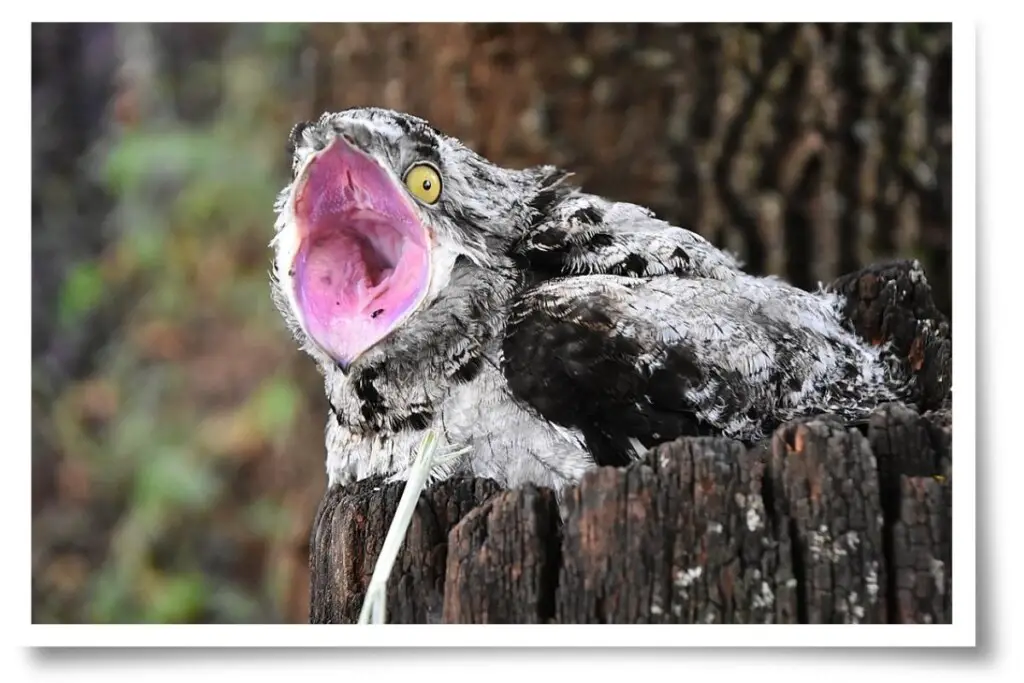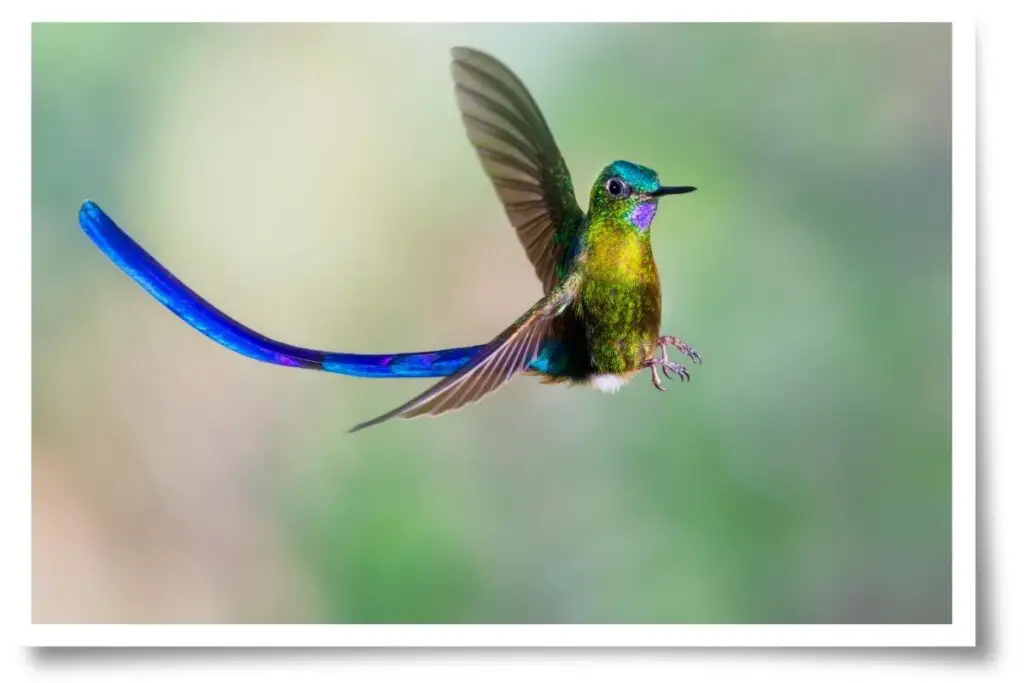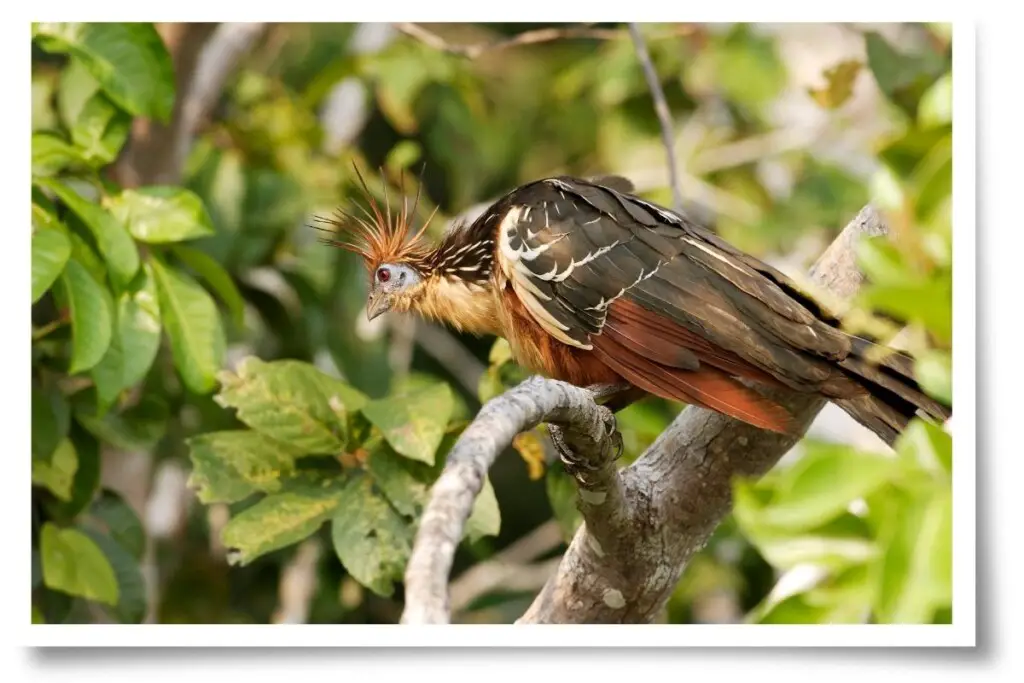South America is a richly diverse continent filled with stunning landscapes, amazing history, and incredible culture. Another thing it has is amazing birds; some of the most unique and mind-blowing birds in the world. In this article, you will discover 10 of them – prepare to be gobsmacked.
1. Horned Screamer
The unicorn of the bird world. Surprisingly, this is not the only bird in the world that has a horn, however, it does have a couple of other features that make it truly unique.

Horned screamers also have spurs on their wings that they use for fighting and huge legs with multiple air sacks which they use for making sounds.

Despite their name, they don’t actually scream though their calls are quite loud. Their calls are similar to ducks or swans to which they are related.
Horned screamers are found from Equador to south-central Brazil. There is also an isolated population in the upper Cuaca Valley of Columbia.
2. Common Potoo
The Common Potoo, known to locals as the Urutau, is definitely a mind-blowing bird. This bird is featured in my Unusual Birds That Will Shock You And Blow Your Mind article.

This bird is one of seven species of potoo (pronounced poe-two). They are nocturnal birds with expert camouflage; their feathers resemble bark covered in lichen. If they sense a threat approaching, potoos will close their eyes, stretch their heads toward the sky, and remain still. When doing this, they look just like a stick or branch of the tree on which they are perched.

The sound that potoos make is also a bit mind-blowing; at least it would be if you heard it in the black of night. It is a kind of owl-like hooting that descends in pitch so that it almost sounds like laughter.
Common potoos will also snap their beaks if threatened. I would not think they would have to do that very often as their camouflage is so effective.
3. Violet-tailed Sylph
This little bird is mind-blowingly beautiful if nothing else…

This species of hummingbird is just 18-21 cm (7.1-8.3 in.) long and that includes the 10-15 cm (3.9-5.9 in.) tail feathers!
These birds are found west of the Andes from Columbia to southwest Ecuador. They are mostly found at an elevation of around 1000 meters but live in cloud forests, forest borders, and semi-open terrains between 1000 and 2000 meters.
What is the purpose of such a long, beautiful tail? To look good for the ladies, of course! Male hummingbirds have developed some incredible physical traits in order to attract a mate. Most notable is their incredible array of bright and iridescent colorings.

I have to wonder if that tail is a hindrance more than anything else. For a bird that has to maneuver around flowers in the forest, it must get in the way at times. Grooming it must also be a bit of an effort.
4. Sword-Billed Humming Bird
From too long in the back, to too long in the front! I bet the violet-tailed sylphs look at these guys and think “wow, I could really use a bill like that to clean my tail!”

Including their bill, these birds are around 17-22.8 cm (6.7-9 in.) in length. This means that their lengthy bills are between 9-11 cm (3.5-4.3 in.) long. What on earth could they need such a huge bill for?
This seemingly ridiculous physical trait is actually a brilliant feeding tool. Sword-billed hummingbirds like to feed on the nectar in long tube-like flowers. Their beaks have developed over time to be perfectly suited to reaching the nectar in these flowers.

Both the male and female birds of this species have these elongated bills. The bills of females are actually longer than that of males. Imagine the strength these birds would need in their flight muscles and neck muscles to hold those long bills up.
Sword-billed hummingbirds actually have one of the largest carina-to-body-size-ratios of any bird. The carina is a ridge of bone projecting from a bird’s sternum to which the flight muscles attach. It is similar in appearance to the keel on a yacht.
5. Hoatzin
Perhaps the smelliest bird in the world, the Hoatzin also features in my Can Birds Fart? – I smell something nasty?! article. They can’t actually fart but you do not want to be around if they burp.

Hoatzins, aside from having a unique look to them, are the only bird in the world that feeds almost exclusively on leaves; they are folivores.
This type of diet, along with a stomach similar to that of a cow, leads to their food being fermented in their bodies. As the fermentation produces a lot of gas, it is likely these birds may burp.
These birds live in the tropical lowland forests of Brazil, Bolivia, Peru, Ecuador, Columbia, Venezuela, Guayana, Suriname, and French Guiana.
Hoatzin chicks are born with claws on their wings which slowly disappear as they grow. Hoatzin nests are built in low trees and shrubs that overhang water and sometimes the chicks fall out. They are competent swimmers but also use their claws to climb their way back to the nest.
6. Andean Cock-of-the-rock
It is not just its name that makes this bird a mind-blowing South American specimen. Meet the national bird of Peru; the Andean Cock-of-the-rock.

The first question you might be asking yourself about this bird is “where on earth is its beak?” It does have one and it is hidden under that phenomenal crest.
These unique birds are found in the Andes from Venezuela to Bolivia. They are around 30.5-32 cm (12-12.6 in.) in length.
Andean cocks-of-the-rock get their name from their preference for nesting on rocky outcrops where they will construct cup-shaped nests from mud. The females will have a clutch of two eggs that take around 28 days to hatch.

Their crests are made up of two rows of fluffy feathers. Female birds also have crests though they are smaller than those of the males.
The male birds will use their crests in mating displays, bowing and bobbing as they jump and flap along branches. Mating displays are performed in a lek, a communal area where up to 15 or more males will display in pairs 4-6 meters above the ground.
7. Many-banded Aracari
Just like a really massive bumblebee with a huge beak. The Many-banded Aracari is our next bird on the list.

You may not be aware that there are 36 species of Toucan, and the many-banded aracari is one of them. These birds are around 43-46 cm (1.4-1.5 ft) in length. Their bills can be anywhere from 10.2 cm to 10.7 cm (4-4.2 in.) long.
These birds are found in low, wet forests in Columbia, Venezuela, Peru, and Brazil. Their large, serrated-edge bills are perfect for plucking fruit from trees or snapping up anthropods.
Scientists have discovered that the huge bills of toucans might be used for heat regulation in the hot tropical sun. They may act as radiators, helping the birds to shed excess heat.

8. Marvelous Spatuletail
The most stylish tail in the forest belongs to the Marvelous Spatuletail.

This is another member of the Hummingbird or Trochilidae family. A tiny bird at just 15-17 cm (5.9-6.7 in.) long, including the tail which is 11-13 cm (4.3-5.1 in.) long. This means that this bird’s body is only 4 cm (1.6 in.) in length!
These beautiful birds are unfortunately on the endangered list and are only found in a small area of Peru. They live in forest edges, second-growth and scrub, open country, steep valleys, and gorges at 2100-2900 m (6889-9514 ft).
Only the males have exceedingly long tails, the tails of the females are elongated but they do not have long shafts with feathery ends. The tails of the males have developed as a rather impressive addition to their mating display as seen in the video below:
The marvelous spatuletail in the video above was obviously circling a potential mate to try and impress her. You can find out why other birds fly in circles in my Finally Revealed! All The Reasons Why Birds Fly In Circles post.
9. Long-wattled Umbrellabird
The Long-wattled Umbrellabird is one of those creatures that make you think “maybe Nature forgot to turn off the production line while it stepped out for a smoke…”

The males of this bird species have a retractable wattle that can be up to 35 cm (13.8 in.) in length. Not only that but they also have a very prominent crest which can be lowered to almost completely cover their beak or held straight up in the air!
What is the point of all this adornment you ask? To attract a mate of course. The males use these features to impress potential mates in bizarre displays like the one seen in the video below:
Long-wattled umbrellabirds are a rare inhabitant of foothills and lowland forests of the Pacific slope of the Andes in Columbia and Ecuador. They are listed as vulnerable with a decreasing population of between 6000 and 15000.
10. White Bellbird
Meet another bird with a rather strange feature; the White Bellbird. The extensible wattle that grows from the top of this bird’s beak is not the only mind-blowing thing about it either.

These are one of the very few all-white land birds. Males are around 28.5 cm (11.22 in.) long and females are around 27.5 cm (10.8 in.).
The females of this species are completely different from the males. They are olive green and do not have a wattle like the males.
The white bellbird is reported to have the loudest call of any bird in the world. Of the four species of the bellbird, it is also the one that sounds most bell-like. I liken its call to a warning alarm in a nuclear power plant!
Conclusion
There you have it…10 mind-blowing birds from South America. There are many, many more unique birds in the world and I will cover those in future articles. Until then, why not read my Unusual Birds That Will Shock You And Blow Your Mind article?
Until next time…happy birding and may you find some unique and mind-blowing birds on your travels.
References
- Birds Of The World – The Cornell Lab of Ornithology
- Additional bird information – Wikipedia
- Bird sounds – xeno-canto.org
